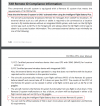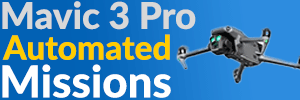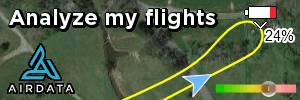Its my understanding the RID on the mmini4pro is only activated when using the longer lasting battery . So if I add a strobe and go over weight my rid does not activate which kinda means I have to buy a rid mod if I want the strobe on which is really not fair. why can't dji make it so we can turn it on or off when needed. Doesn't seam that that would be to hard to do . COME ON DJI
You are using an out of date browser. It may not display this or other websites correctly.
You should upgrade or use an alternative browser.
You should upgrade or use an alternative browser.
RID ?
- Thread starter Daytona500
- Start date
The FAA does not permit the RID function to be switched on and off by the pilot. Please join the discussion here to get some answers to this confusing situation: M3P RFID disabled w/ 249gr battery?
- Joined
- Oct 12, 2016
- Messages
- 30,337
- Reactions
- 34,264
- Location
- Harrisburg, PA (US)
- Site
- mavichelp.com
That's correct per the current Mini 4 Pro manual:

For now, the best option would be to purchase a Battery Plus battery if you need to use RID with your Mini 4 Pro. They are available here on Amazon or here in the DJI Store.

For now, the best option would be to purchase a Battery Plus battery if you need to use RID with your Mini 4 Pro. They are available here on Amazon or here in the DJI Store.
Last edited:
RetiredInFL
Very Large Member
For now, the best option would be to purchase a Battery Plus battery if you need to use RID with your Mini 4 Pro. They are available here on Amazon or here in the DJI Store.
Best option for DJI for sure! Put on a set of $15 prop guards and have to spend another $95 + tax on a battery to use it (legally). Had I known that BEFORE buying the 3 battery "standard" kit I would have started with the extended battery kit to begin with, which, for my use, I really have no need for.
- Joined
- Oct 12, 2016
- Messages
- 30,337
- Reactions
- 34,264
- Location
- Harrisburg, PA (US)
- Site
- mavichelp.com
The only other alternative would be to buy an RID module (like the Holy Stone RID module) for nearly the same cost. The battery seems to be the lesser of the two evils for those who must use RID right now.Best option for DJI for sure!
RetiredInFL
Very Large Member
Right, and that doesn't change my opinion of the "system." Either way it puts the owner out of pocket about $100 just to "legally" add a set of prop guards. Maybe DJI can have a software workaround by allowing the user to set a software switch saying they have the larger battery when they don't. That would avoid the legality of allowing a consumer to turn RID off or on with either battery,The only other alternative would be to buy an RID module (like the Holy Stone RID module) for nearly the same cost. The battery seems to be the lesser of the two evils for those who must use RID right now.
I think DJI will eventually come up with something to fix this as it makes little sense for the true recreational flyer to have to buy a battery (or additional device) to try and be legal.
- Joined
- Oct 12, 2016
- Messages
- 30,337
- Reactions
- 34,264
- Location
- Harrisburg, PA (US)
- Site
- mavichelp.com
Ah, well, I wasn't commenting about "the system". But, sure, I don't think you'll find anyone who disagrees with your opinion on the system. DJI could certainly allow RID to always be enabled (at the least).Right, and that doesn't change my opinion of the "system."
According to DJI, the true recreational flyer is the flyer who purchases the <250g drone purely for recreational purposes and attaches nothing to the drone to tip it over 250g. I don't have the numbers but that's probably 95%. Are you asking DJI to make concessions for the other 5% beyond the one solution they have already offered (which is to insert the heavy battery and call it a day)?I think DJI will eventually come up with something to fix this as it makes little sense for the true recreational flyer to have to buy a battery (or additional device) to try and be legal.
Honestly, there is no solution that works for everybody 100% unless you include the broadcast module. Bottom line is DJI has done us all a favor by making RID available in the Mini drone series at all. They could have kept it super simple: It's a recreational drone and it never has standard RID and if you want to use it for commercial work, fine; get a broadcast module. Instead, they got creative. Want to attach strobes and prop guards (i.e. you're in that 5%), get a heavy battery....or go one more and attach a module instead; you have options. Rules and regulations and compliance notwithstanding.
Hmmm you only think 5% want to fly at night or add a strobe for daytime visibility, or landing gear for high grass. I would think its a much higher % but what do I know


StevenBrodsky
Well-Known Member
Wow. interesting how law abiding some people are. Or, is it brainwashed?
If you so into the law, get the larger battery, and use it when you want to add stuff to the mini.
Me? Id fly with stuff on it and just play dumb, if a knowledgeable LE officer caught me. That's just me.
If you so into the law, get the larger battery, and use it when you want to add stuff to the mini.
Me? Id fly with stuff on it and just play dumb, if a knowledgeable LE officer caught me. That's just me.
This is what said DJI probably thinks:Hmmm you only think 5% want to fly at night or add a strobe for daytime visibility, or landing gear for high grass. I would think its a much higher % but what do I know
Notice my guess contains two pieces: lightweight drone *plus* nothing attached to it. DJI does not recommend attaching anything to the drone so they cannot plan for it otherwise they wouldn't stamp 250g on the drone. When DJI exceeds the weight themselves (heavy battery) they act on the claim according but not for 3rd party items.....the flyer who purchases the <250g drone purely for recreational purposes and attaches nothing to the drone to tip it over 250g.
I also said:
which means I don't know for sure but yes, I exaggerate a bit. The point is it's overwhelming and is likely why DJI made the decision. I will say in the past, DJI thinks about these extra items as "payload mode" and they throttle the drone performance. For sure when they reference their hobby sub-250g class drone, they count every one of them even though they know the weight may creep slightly above. But they won't trigger RID for you when payload is detected, will they?I don't have the numbers but that's probably 95%.
Unfortunately DJI has decided to play with the numbers by detecting the minor weight differences and acting upon them. If they were more like you and I, they would just put 249g on all the batteries and call it a day. But they noticed it....and so should we.Wow. interesting how law abiding some people are. Or, is it brainwashed?
If you so into the law, get the larger battery, and use it when you want to add stuff to the mini.
Me? Id fly with stuff on it and just play dumb, if a knowledgeable LE officer caught me. That's just me.
This is just my opinion. You cannot afford to play dumb. Because the penalties are just too high if you get caught *and* you didn't catch a break. If it were known to be a $50 ticket, fine. But the FAA/police like to charge you with federal/state felonies and only after you (and your lawyer) cave it, they drop it and come to their senses because they get their satisfaction from the message it sends, not for the gravity of the infraction. In the meantime, if you are anybody, the implications could be enormous for you. Because it is an unforced, self-inflicted risk that you could have easily avoided and there are no do-overs. I hate it too but I think I would dislike all the hate and unwanted attention even more. That guy who flew his drone near the stadium, how do you think he feels; his family told him not to even spend all their money on that stupid drone and now what?
StevenBrodsky
Well-Known Member
True.Unfortunately DJI has decided to play with the numbers by detecting the minor weight differences and acting upon them. If they were more like you and I, they would just put 249g on all the batteries and call it a day. But they noticed it....and so should we.
This is just my opinion. You cannot afford to play dumb. Because the penalties are just too high if you get caught *and* you didn't catch a break. If it were known to be a $50 ticket, fine. But the FAA/police like to charge you with federal/state felonies and only after you (and your lawyer) cave it, they drop it and come to their senses because they get their satisfaction from the message it sends, not for the gravity of the infraction. In the meantime, if you are anybody, the implications could be enormous for you. Because it is an unforced, self-inflicted risk that you could have easily avoided and there are no do-overs. I hate it too but I think I would dislike all the hate and unwanted attention even more. That guy who flew his drone near the stadium, how do you think he feels; his family told him not to even spend all their money on that stupid drone and now what?
I wonder how that stadium flyer got caught anyway. Of course, "they" never tell us. I can't imagine some guy standing in an obviously noticeable place, flying his drone over a stadium where everyone can see it, then slowly flying it back to his location, in such a way, that LE can follow it to him. That's just naive or stupid. Maybe some people actually don't know you can't do certain things with drones.
Of course it was simple as that. No need for RID or Aeroscope or sophisticated tool designed to thwart the [non-existent] "bad guy" up to no good. The article says:True.
I wonder how that stadium flyer got caught anyway. Of course, "they" never tell us. I can't imagine some guy standing in an obviously noticeable place, flying his drone over a stadium where everyone can see it, then slowly flying it back to his location, in such a way, that LE can follow it to him. That's just naive or stupid. Maybe some people actually don't know you can't do certain things with drones.
"MSP Troopers tracked the movement of the drone directly over the stadium and deployed to the area where the drone landed in the 500 block of South Sharp Street in Baltimore. FBI agents traveled to that location and assisted MSP Troopers. [The suspect] was located at that location and spoke with law enforcement."
Pennsylvania Man Facing Federal Felony Charges for Illegally Operating a Drone During the National Football League’s AFC Championship Game
Fly safely everyone. https://www.justice.gov/usao-md/pr/pennsylvania-man-facing-federal-felony-charges-illegally-operating-drone-during-national
StevenBrodsky
Well-Known Member
Holy Crap. He really was that stupid or just naive about laws or just what not to do if you don't want to be approached by LE. I learned my lesson the first few times i flew a drone. I didn't really know the rules long ago and I didn't know how to avoid being found. But now I know the rules and definitely know how to avoid people of any sort, including LE.Of course it was simple as that. No need for RID or Aeroscope or sophisticated tool designed to thwart the [non-existent] "bad guy" up to no good. The article says:
"MSP Troopers tracked the movement of the drone directly over the stadium and deployed to the area where the drone landed in the 500 block of South Sharp Street in Baltimore. FBI agents traveled to that location and assisted MSP Troopers. [The suspect] was located at that location and spoke with law enforcement."
Pennsylvania Man Facing Federal Felony Charges for Illegally Operating a Drone During the National Football League’s AFC Championship Game
Fly safely everyone. https://www.justice.gov/usao-md/pr/pennsylvania-man-facing-federal-felony-charges-illegally-operating-drone-during-nationalmavicpilots.com
All he had to do is do his fly over of the stadium, then make sure his drone is seen flying in the opposite direction of where he is and landing in the opposite direction of where he is, then suddenly take off to 400ft agl, making it hard to see the drone, fly to his home point, land it and throw it in his back pack or trunk and make his get away. But, I really don't think he had a clue he was really doing something very illegal.
RetiredInFL
Very Large Member
According to DJI, the true recreational flyer is the flyer who purchases the <250g drone purely for recreational purposes and attaches nothing to the drone to tip it over 250g. I don't have the numbers but that's probably 95%. Are you asking DJI to make concessions for the other 5% beyond the one solution they have already offered (which is to insert the heavy battery and call it a day)?
Honestly, there is no solution that works for everybody 100% unless you include the broadcast module. Bottom line is DJI has done us all a favor by making RID available in the Mini drone series at all. They could have kept it super simple: It's a recreational drone and it never has standard RID and if you want to use it for commercial work, fine; get a broadcast module. Instead, they got creative. Want to attach strobes and prop guards (i.e. you're in that 5%), get a heavy battery....or go one more and attach a module instead; you have options. Rules and regulations and compliance notwithstanding.
You really think they did anyone a favor by adding RID ?? Really ?? I'd think the FEDs had a little something to do with it. Reading this forum and a few others, reading the reviews and watching Youtube it sure SEEMS like a lot LESS than 95% of the Mini 4 *PRO* users buy it strictly for recreational use.
That being said, as I mentioned in my previous post I'm sure with their infinite knowledge they could work around this issue with a simple software option to turn on RID when the "normal recreational battery" is attached just as they can turn it OFF automatically with it attached, They could call it "purely recreational LEGAL flyer RID", or maybe Prop guard RID. Prop guards are for SAFETY but should not warrant spending another $100 to make "purely recreational flyers" legal. I'm sure there are also lots of other "cool gimmicks" that "purely recreational flyers" would like to do to customize their little toy like skins or putting TayTay's photo on the bottom and still remain "purely recreational."
Good conversation and understandable this is where we landed today and looking back in hindsight, perhaps could have done it differently. The Mini 3 Pro was likely developed and thought-out a year before it launched May 2022 so let's say mid-2021 or maybe [pandemic] earlier...while the Mini 2 was the sub-250 statement. Someone probably thought let's leave the Mini 2 alone with no RID and make the Mini 3 with remote ID. Remember, I keep saying excessive government rules and over-regulation only burden the industry, slow it down, get in the way, make it less nimble; and DJI didn't always understand the RID confusion at that time. There was a thing called "if you build a drone for sale in the US past [a certain date], it better have RID." So you are right, the government probably forced this one, telling DJI don't go and make a millions toy drones without RID for sale in the US else it will take decades to get them "under control." Only later has DJI learned to "cope" with what we know today as RID. In fact, we've all learned a thing or two as of today and unfortunately, the implementation or the correction to make it good going back to earlier models is not going to be clean. Just look at all the various solutions from attaching phones to built-in googles, to drones left out in the cold, to Mavic 2 series win...and now we have Mini 3/4 software. This is a support nightmare for DJI.You really think they did anyone a favor by adding RID ?? Really ?? I'd think the FEDs had a little something to do with it. Reading this forum and a few others, reading the reviews and watching Youtube it sure SEEMS like a lot LESS than 95% of the Mini 4 *PRO* users buy it strictly for recreational use.. Speaking AS a purely recreational user I would like to add a set of prop guards for safety without having to (legally) spend another $100.
That being said, as I mentioned in my previous post I'm sure with their infinite knowledge they could work around this issue with a simple software option to turn on RID when the "normal recreational battery" is attached just as they can turn it OFF automatically with it attached, They could call it "purely recreational LEGAL flyer RID", or maybe Prop guard RID. Prop guards are for SAFETY but should not warrant spending another $100 to make "purely recreational flyers" legal. I'm sure there are also lots of other "cool gimmicks" that "purely recreational flyers" would like to do to customize their little toy like skins or putting TayTay's photo on the bottom and still remain "purely recreational.".
DJI probably thought broadcast modules were going to be $50 for example. When they created prop guards, I'm sure the accessory manufacturer didn't have any idea about "overweight" for RID restrictions, etc. If you want cheap props, they can't be tied into the software. So there's no reliable way to control this and tie it into RID. The RID rules say the props don't spin until RID is confirmed; plastic attachments don't resolve this.
In order for DJI to implement RID, they had to following the government rules. You can start reading about the Means of Compliance here so just like any government regulation, it's not easy to fully understand what it takes to comply. In other words, DJI couldn't just pull together whatever scheme they thought would work best for their customer base. Instead someone probably said, just go ahead and put it in every drone and call it a day. We have customers around the world and the laws are different in every country, we do what we can. In the meantime, nobody else will darn get involved in this nightmare where the rules change every six months and nobody get grandfathered and you have no idea where the craziness will go....only big DJI can deal with it and ultimately they didn't do the best job either considering the other distractions they face.
RID is not a commercial vs recreational feature. As you can see, the DoC is out of step when it comes to serial numbers, we have drones broadcasting RID details that are *not* in the FAA database, and on top of that (this is just a guess), we have very little overall compliance with a new deadline approaching next month. How anyone can call this successful....one more thing, reminder about the ON/OFF switch for RID, here are the rules, tell me if you think your solution complies:
This is what the FAA says about RID and a switch and it has less to do with being "legal" or not and more to do with whether there is a DoC for your serial number:
§ 89.310 Minimum performance requirements for standard remote identification unmanned aircraft.
A standard remote identification unmanned aircraft must meet the following minimum performance requirements:
(a) Control station location. The location of the control station of the unmanned aircraft must be generated and encoded into the message elements and must correspond to the location of the person manipulating the flight controls of the unmanned aircraft system.
(b) Time mark. The time mark message element must be synchronized with all other remote identification message elements.
(c) Self-testing and monitoring.
(1) Prior to takeoff, the unmanned aircraft must automatically test the remote identification functionality and notify the person manipulating the flight controls of the unmanned aircraft system of the result of the test.
(2) The unmanned aircraft must not be able to take off if the remote identification equipment is not functional.
(3) The unmanned aircraft must continuously monitor the remote identification functionality from takeoff to shutdown and must provide notification of malfunction or failure to the person manipulating the flight controls of the unmanned aircraft system.
(d) Tamper resistance. The unmanned aircraft must be designed and produced in a way that reduces the ability of a person to tamper with the remote identification functionality.
Source: Federal Register :: Request Access
Source: https://www.faa.gov/sites/faa.gov/files/2021-08/RemoteID_Final_Rule.pdf
Here's an excerpt about MoC:
Under this rule, anyone can create a means of compliance; however, the FAA must
accept that means of compliance before it can be used for the design or production of any
standard remote identification unmanned aircraft or remote identification broadcast module. A
person seeking acceptance by the FAA of a means of compliance for standard remote
identification unmanned aircraft or remote identification broadcast modules is required to submit
the means of compliance to the FAA. The FAA reviews the means of compliance to determine if
it meets the minimum performance requirements and includes appropriate testing and validation
procedures in accordance with the rule. Specifically, the person must submit a detailed
description of the means of compliance, a justification for how the means of compliance meets
the minimum performance requirements of the rule, and any substantiating material the person
wishes the FAA to consider as part of the application. FAA-accepted consensus standards are
one way, but not the only way, to show compliance with the performance requirements of this
rule. Accordingly, the FAA encourages consensus standards bodies to develop means of
compliance and submit them to the FAA for acceptance.
Disclaimer: The internet is full of FAA documentation and as a layperson and non-expert, I don't always find the latest and most current information to quote. Often the documents are in draft, have changed, or there is superseding information so please understand this caveat which basically says I could be way off base. I have no idea who is following the rules, or not.
I'm really glad DJI disabled RID on the Mini Pro 4 when flown with the regular battery. This was one of my only complaints about it. I'm a recreational pilot and I don't need or want RID running on my Drone. The WiFi transmission wastes precious battery power and reduces flight time, not to mention exposing my location unnecessarily.
StevenBrodsky
Well-Known Member
Im flying a Mav3E and an Air3, I've used my tablet and a few of those RID apps to try to see if they could identify either of my drones after I launched them, but these apps just state 0 drons found. The Apps and Tablet are android.I'm really glad DJI disabled RID on the Mini Pro 4 when flown with the regular battery. This was one of my only complaints about it. I'm a recreational pilot and I don't need or want RID running on my Drone. The WiFi transmission wastes precious battery power and reduces flight time, not to mention exposing my location unnecessarily.
I've looked all over the my drone's apps and can't find where it says RID is on or active.
Is there a way to see if RID is on or active a MAV3E or the Air3?
What's the best android app I can use to see if RID is transmitting from my drone?
Similar threads
- Replies
- 17
- Views
- 957
- Replies
- 134
- Views
- 10K
- Replies
- 2
- Views
- 860
- Replies
- 25
- Views
- 3K
- Replies
- 16
- Views
- 3K
DJI Drone Deals
New Threads
-
-
4 Pro Night Christmas Boats Parade
- Started by MikeReidPhotography
- Replies: 1
-
-
Mini 5 Pro Mist-erious Forest | West Coast rainforest with Mini 5 Pro & 3 Pro
- Started by DMD Cine Attic
- Replies: 2
-
Members online
Total: 3,143 (members: 7, guests: 3,136)










